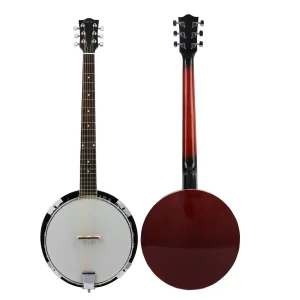Contents
- 1 The Banjo: From Its African Roots to Its Influence on Australian Folk and Bush Music
- 1.1 African Beginnings: The Banjo’s Earliest Roots
- 1.2 The Banjo’s Transformation in the Americas
- 1.3 The Banjo’s Role in Folk and Bluegrass
- 1.4 How the Banjo Found Its Way to Australia
- 1.5 The Decline and Rediscovery of the Banjo
- 1.6 The Modern Banjo Revival in Australia
- 1.7 Why the Banjo Endures
- 1.8 The Future of the Banjo
- 1.9 Final Thoughts
- 1.10 Mastering Banjo Chords
- 1.11 The Ultimate Guide to Choosing and Caring for Banjo Strings
- 1.12 Different Types of Banjos and their Characteristics
The Banjo: From Its African Roots to Its Influence on Australian Folk and Bush Music
 The banjo, with its twangy strings and infectious rhythm, has one of the most interesting stories in music history. Its sound can lift spirits, spark a dance, and tell tales of hardship, joy, and identity. While many people associate the banjo with bluegrass or American folk music, its origins are far older and more global, stretching back to Africa and evolving through centuries of cultural exchange.
The banjo, with its twangy strings and infectious rhythm, has one of the most interesting stories in music history. Its sound can lift spirits, spark a dance, and tell tales of hardship, joy, and identity. While many people associate the banjo with bluegrass or American folk music, its origins are far older and more global, stretching back to Africa and evolving through centuries of cultural exchange.
Today, this once-humble instrument is enjoying a resurgence, including a growing presence in Australia’s folk and bush music scenes. Let’s look at how the banjo’s story unfolded, and why its legacy continues to resonate so strongly.
African Beginnings: The Banjo’s Earliest Roots
The banjo’s true story begins in West Africa. Long before the word “banjo” even existed, African musicians played instruments with gourd bodies, stretched animal skins, and necks strung with gut or fibre strings. These early instruments — known by names like akonting, ngoni, and xalam — were not just for music but were deeply tied to storytelling, ceremony, and community.
When enslaved Africans were taken to the Americas during the 17th and 18th centuries, they carried with them their traditions and musical knowledge. On plantations, they recreated their native instruments using available materials like gourds, wood, and animal hide. These became the early prototypes of what would later evolve into the modern banjo.
The rhythmic, percussive quality of these instruments helped shape early African American musical forms, and eventually laid the foundation for blues, jazz, and even country music.
The Banjo’s Transformation in the Americas
As the instrument spread through the Caribbean and into North America, it caught the attention of European settlers. By the early 1800s, white musicians began adopting and modifying the banjo, adding frets and refining its design. Unfortunately, much of this adaptation occurred through minstrel shows — travelling performances that often perpetuated racial stereotypes while popularising African American music.
Despite this troubled history, the banjo became firmly embedded in the American musical landscape. It evolved from a handmade folk instrument into a commercially produced one, particularly during the 19th century. By the late 1800s, it had entered parlour music and later found a new home in early jazz and bluegrass.
The Banjo’s Role in Folk and Bluegrass
The 20th century saw the banjo rise to iconic status. With five strings, a circular body, and a bright, lively sound, it became the heartbeat of American bluegrass music. Artists like Earl Scruggs transformed how it was played — introducing the famous three-finger picking style that defined a generation of musicians.
The banjo was no longer just a background rhythm instrument. It took centre stage, adding drive, melody, and personality to countless folk and country songs. By mid-century, it had become a global symbol of Americana, but its influence was spreading much further.
How the Banjo Found Its Way to Australia
The banjo made its way to Australia during the 1800s, likely brought by British and American sailors, gold rush migrants, and travelling performers. Its portability and lively sound made it perfect for campfire sing-alongs, bush dances, and outback gatherings.
As Australian folk and bush music developed, the banjo became a natural fit. It complemented the fiddle, concertina, and guitar, adding rhythm and spark to songs that celebrated rural life, mateship, and the rugged beauty of the Australian landscape.
In the 19th and early 20th centuries, bush musicians often played a mix of Irish, Scottish, and English tunes blended with local storytelling and humour. The banjo found a home among these traditions, its distinctive sound echoing across shearing sheds and pub sessions from the outback to the coast.
The Decline and Rediscovery of the Banjo
Like many traditional instruments, the banjo saw a decline during the mid-20th century as modern pop and rock music took over the airwaves. Electric guitars and drum kits replaced fiddles and banjos in mainstream entertainment.
But folk revival movements in the 1960s and 1970s brought the instrument back into the spotlight. Artists such as Pete Seeger and later Béla Fleck reimagined the banjo’s possibilities, proving it could be just as expressive in classical, jazz, and even world music contexts.
In Australia, the folk revival mirrored this trend. Bands and solo artists began rediscovering old bush ballads, folk tunes, and acoustic instruments. The banjo once again took its rightful place among the instruments that shaped Australian cultural identity.
The Modern Banjo Revival in Australia
Today, the banjo is enjoying a resurgence across Australia’s folk, country, and indie music scenes. From folk festivals in Victoria and New South Wales to bluegrass sessions in Queensland, the instrument is finding new audiences and new voices.
Contemporary Australian artists are experimenting with blending traditional banjo sounds with modern influences, from Americana to indie folk and even alternative rock. Musicians like Daniel Watkins, The Morrisons, and Mustered Courage have helped reintroduce the banjo to a younger audience, proving its versatility and charm.
Meanwhile, community music groups and local luthiers are keeping the craft alive. Workshops, open mic nights, and folk festivals across the country celebrate the banjo as both a historical relic and a living, evolving instrument.
Why the Banjo Endures
So why does the banjo continue to fascinate and inspire? Perhaps it’s because its sound feels both joyful and nostalgic, capable of expressing complex emotions while making your foot tap along. It speaks of journeys, struggles, and resilience.
In Australia, the banjo resonates because it fits perfectly into the national story, a land of pioneers, storytellers, and people who find rhythm and meaning in life’s simple moments. Whether played around a campfire, on a festival stage, or in a recording studio, the banjo connects the past and present in a way few instruments can.
The Future of the Banjo
With growing interest in acoustic and roots music, the future of the banjo looks bright. Online tutorials, Australian folk schools, and social media have made learning the instrument more accessible than ever. New generations of players are exploring its African heritage, its American transformations, and its unique place in Australian music culture.
The banjo’s global story, from African villages to Australian festivals, is a testament to music’s power to travel, adapt, and unite people. Each strum carries echoes of history, tradition, and the shared human love of rhythm and melody.
Final Thoughts
 The banjo is more than just a quirky stringed instrument; it’s a bridge between cultures, continents, and generations. Its African beginnings, American evolution, and Australian revival show how deeply interconnected music can be.
The banjo is more than just a quirky stringed instrument; it’s a bridge between cultures, continents, and generations. Its African beginnings, American evolution, and Australian revival show how deeply interconnected music can be.
So next time you hear that distinctive twang at a bush dance or folk festival, remember you’re not just listening to an instrument. You’re hearing centuries of history, culture, and human connection, all strung together in one unforgettable sound.
